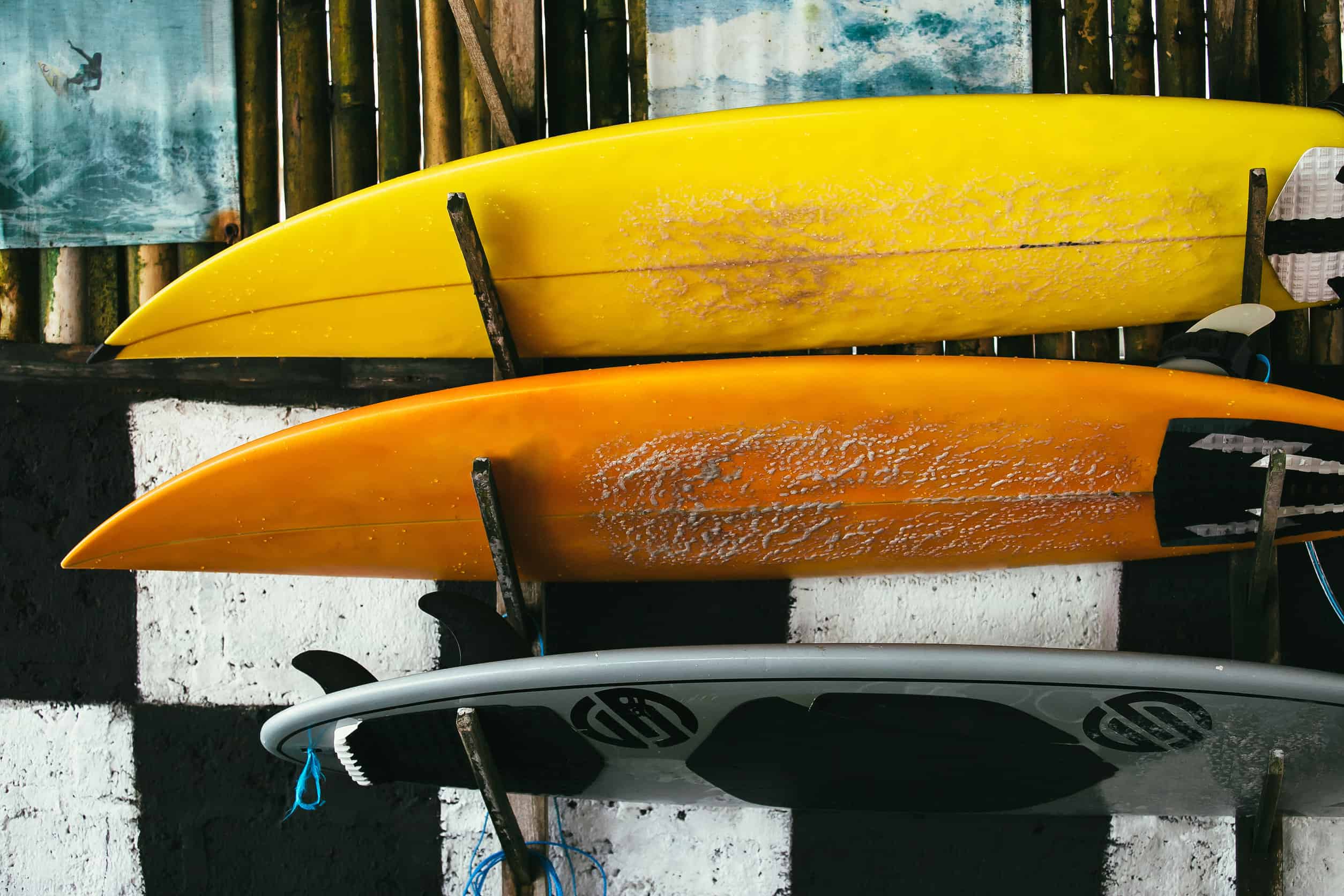Surfboards come in all shapes and sizes – and for a good reason. Each surfboard style is ideal for certain surf conditions, and using the right one will help you have the best ride ever.
Generally, you should use longer boards with high volumes for slow and large waves. Shorter ones with wider bodies are better for fast and choppy waves.
So, how does size impact your ride? Let’s talk about the components of a surfboard’s size and find the perfect one for you. I’ll tell you all about how wave conditions should affect your choice and help you figure out when you need a longer or shorter board.
Wave Conditions and the Ideal Boards for Them
Choosing the right board for the wave conditions at your favorite surf spot can help you get a long, smooth ride in.
You’ll need a different board for wave conditions such as slow, fat beach breaks, short, choppy waves and point breaks, and big waves. That’s because each size board is optimal for specific wavelengths and speeds, and if you use the right one, you’ll be able to maneuver better.
Slow, Fat Beach Breaks
Long, thick boards do very well in slow, rolling waves since they offer plenty of stability and drag for a pleasant cruise. Since you won’t be racing the breaks with these mellow waves, a taller and slower board with a thick body will offer you a longer ride before you have to paddle back out again.
Longboards are usually between 8 and 10 feet (2.4 and 3.0 m) long, and they offer the most classic, most leisurely surf for a chill day at the beach.
Short, Choppy Waves and Point Breaks
A short surfboard will offer you the most control and balance when maneuvering between frequent short, choppy waves. Instead of balancing on your board between the troughs, a shortboard will carry you through them, allowing you to get a smooth ride no matter how punchy the waves get.
Shortboards are also excellent on point break waves, barrel-style waves that soar over the coastline, making a perfect tunnel of water. That’s because they’re easy to maneuver and won’t bog you down, allowing you to ride the wave before or as it breaks.
Shortboards, which usually come in at 5 to 7 feet (1.5 to 2.1 m) long, don’t offer much stability since they don’t cover as much water as longer boards, but they’re easy to control and move. Because of how easily they can move, many pro surfers prefer shortboards for all kinds of surfing.
Big Waves
The surfboard size that pro surfers turn to when conquering gigantic waves is the gun-style board, usually measuring between 7 and 11 feet (2.1 to 3.4 m) long. Gun style boards aren’t very thick or broad, but they have long teardrop-shaped bodies that help maintain the board’s balance.
These long, narrow boards require skill to use, but they move quickly while helping you keep your balance, no matter how high you go.
How Do I Choose the Right Size Surfboard?
When you choose a surfboard, you need it to fit your body in a way that’ll help you stay on your feet, regardless of whether the waves are short and choppy or long and tall. To measure how well a board will work for you and the types of tides you like to surf on, you’ll need to consider the volume, height, and shape of your surfboard.
To choose the right surfboard size for you, you’ll need to consider and measure the board’s volume, width, height, and thickness. These measurements should match your body’s weight and height, your experience level, and the waves you want to ride on.
So, let’s break down the components that determine the size of a surfboard and talk about what each measurement means.
A Surfboard’s Volume
The volume of a surfboard is measured in liters. This measurement is calculated with the formula:
Length of the board x the width x the height
This measurement is one of the most important factors to consider when choosing a board for any wave conditions. That’s because the volume includes the height, length, and thickness of the board, which are all crucial factors to consider when you set out for specific tide types.
Low-volume boards are lighter, and they can be more challenging to control, especially for riders who are a bit on the heavier side. They sit a bit lower on the top of the water since they’re less buoyant, making the board sensitive to each of your movements.
So, low-volume surfboards have very little forgiveness when you are out on the water, but they can be easier to move, making them better for waves that come in and break quickly.
High-volume boards are ideal for beginner surfers, and they’re the most common type of surfboard used in surf schools. They’re usually thicker, which makes them float effortlessly, and they have broad coverage, making them far less sensitive to your movements.
Since high-volume boards are sturdy and stable, like boats, they’re ideal for surfing on slower, calm waves that gently roll in.
However, high-volume boards are usually too slow and hard to move for advanced surfers who like to catch fast-paced waves, so you’ll generally graduate to a shorter, narrower board as you gain experience.
Because volume can affect how easy it’s to control a surfboard, your experience level will play a role in deciding what kind of board is ideal for you.
That said, your height and weight will also impact how these boards work for you. If you’re relatively short or a child, a low-volume surfboard might fit you the same way that a high-volume surfboard fits a tall 200 lb (90.7 kg) man. For the best board experience, adjustments should be made for your weight.
If you want to determine what volume surfboard is best for your experience level, height, and weight, you can use this simple volume calculator .
.
A Surfboard’s Width
The width of a surfboard is measured from rail to rail at the broadest part of the board. The width can make a big difference when surfing in different water conditions.
Wider boards offer more stability since they are more difficult to tip, but they also lack the maneuverability of a slender, narrow board.
Skinny boards also move faster since they have a hydrodynamic design, making them perfect for traveling through more giant waves at high speeds.
So, when you’re a beginner and need to take things slowly, using a wider surfboard of 20 to 22 inches (50.8 to 55.88 cm) is ideal. Narrower boards with widths of 17 to 19 inches (43.2 to 48.3 cm) are best for people with plenty of experience who want to increase their speeds and coast along taller waves.
A Surfboard’s Height
The height, or length, of a surfboard usually differs depending on the waves you’re surfing.
Shorter boards float better on top of snappy, high-frequency, or shallow waves since they can better maneuver over and under sharp crests and troughs. These smaller boards are also easy to move and control since they usually have less volume and weight than longboards.
With a longer surfboard, riding short waves is much more difficult since the board’s nose can easily get pushed into the next crest, causing an issue with imbalance, possibly sending you off your board.
However, longer boards are best for riding through barrel waves and taller waves farther from the coast. Since the bottom of the board is longer, they also offer a more secure platform to surf on, making them perfect for catching powerful currents.
A Surfboard’s Thickness
Thicker surfboards are more difficult to control than thin surfboards, but they have more float, making them ideal for beginners surfing on shallow waves.
Thin surfboards are much easier to maneuver since they’re lighter, but they’re also faster and harder to balance on than thick boards.
Final Thoughts
When determining the size of your board, you need to factor the volume, width, height, and thickness to ensure that you have the right match for your body and experience level.
Longboards are best suited for surfing slow waves and beach breaks since they’re so balanced, while shortboards are better for choppy and fast waves that require more maneuvering. For big waves, pros use gun boards, which have superior speed and balance.

